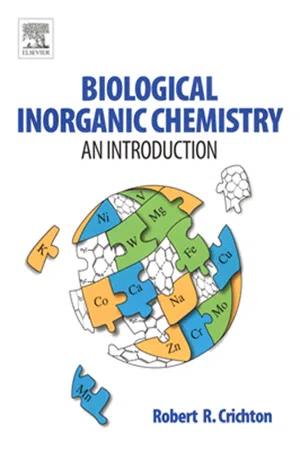
Biological Inorganic Chemistry
An Introduction
Robert R. Crichton
- 381 pages
- English
- ePUB (mobile friendly)
- Available on iOS & Android
Biological Inorganic Chemistry
An Introduction
Robert R. Crichton
About This Book
The importance of metals in biology, the environment and medicine has become increasingly evident over the last twenty five years. The study of the multiple roles of metal ions in biological systems, the rapidly expanding interface between inorganic chemistry and biology constitutes the subject called Biological Inorganic Chemistry. The present text, written by a biochemist, with a long career experience in the field (particularly iron and copper) presents an introduction to this exciting and dynamic field. The book begins with introductory chapters, which together constitute an overview of the concepts, both chemical and biological, which are required to equip the reader for the detailed analysis which follows. Pathways of metal assimilation, storage and transport, as well as metal homeostasis are dealt with next. Thereafter, individual chapters discuss the roles of sodium and potassium, magnesium, calcium, zinc, iron, copper, nickel and cobalt, manganese, and finally molybdenum, vanadium, tungsten and chromium. The final three chapters provide a tantalising view of the roles of metals in brain function, biomineralization and a brief illustration of their importance in both medicine and the environment.Relaxed and agreeable writing style. The reader will not only fiind the book easy to read, the fascinating anecdotes and footnotes will give him pegs to hang important ideas on.Written by a biochemist. Will enable the reader to more readily grasp the biological and clinical relevance of the subject.Many colour illustrations. Enables easier visualization of molecular mechanismsWritten by a single author. Ensures homgeneity of style and effective cross referencing between chapters
Frequently asked questions
Information
An Overview of Metals in Biology
Publisher Summary
INTRODUCTION
WHY DO WE NEED ANYTHING OTHER THAN C, H, N AND O (TOGETHER WITH SOME P AND S)?
| Metal ion | Binding | Mobility | Function |
| Na+, K+ | Weak | High | Charge carriers |
| Mg2+, Ca2+ | Moderate | Semi-mobile | Triggers, transfers structural |
| Zn2+ | Moderate/strong | Intermediate | Lewis acid, structura... |
Table of contents
- Cover image
- Title page
- Table of Contents
- Preface
- Chapter 1: An Overview of Metals in Biology
- Chapter 2: Basic Coordination Chemistry for Biologists
- Chapter 3: Biological Ligands for Metal Ions
- Chapter 4: Structural and Molecular Biology for Chemists
- Chapter 5: An Overview of Intermediary Metabolism and Bioenergetics
- Chapter 6: Methods to Study Metals in Biological Systems
- Chapter 7: Metal Assimilation Pathways
- Chapter 8: Transport, Storage and Homeostasis of Metal Ions
- Chapter 9: Sodium and Potassium—Channels and Pumps
- Chapter 10: Magnesium–Phosphate Metabolism and Photoreceptors
- Chapter 11: Calcium: Cellular Signalling
- Chapter 12: Zinc: Lewis Acid and Gene Regulator
- Chapter 13: Iron: Essential for Almost All Life
- Chapter 14: Copper: Coping with Dioxygen
- Chapter 15: Nickel and Cobalt: Evolutionary Relics
- Chapter 16: Manganese: Water Splitting, Oxygen Atom Donor
- Chapter 17: Molybdenum, Tungsten, Vanadium and Chromium
- Chapter 18: Metals in Brain and Their Role in Various Neurodegenerative Diseases
- Chapter 19: Biomineralization
- Chapter 20: Metals in Medicine and the Environment
- Index